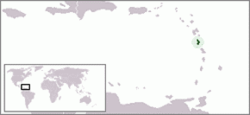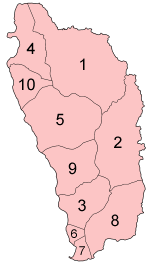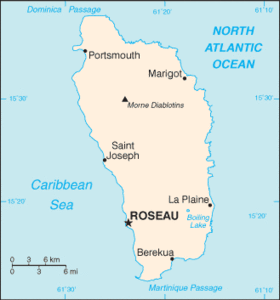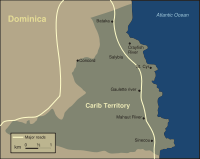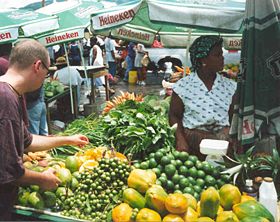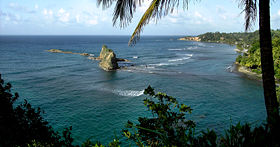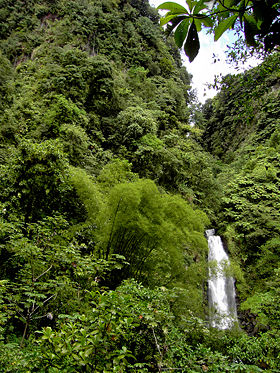Dominica
2008/9 Schools Wikipedia Selection. Related subjects: Americas; Countries
| Commonwealth of Dominica | ||||||
|---|---|---|---|---|---|---|
|
||||||
| Motto: "Après Bondie, C'est La Ter" ( Antillean Creole) "After God is the Earth" |
||||||
| Anthem: Isle of Beauty, Isle of Splendour |
||||||
|
|
||||||
| Capital (and largest city) |
Roseau |
|||||
| Official languages | English | |||||
| Demonym | Dominican | |||||
| Government | Parliamentary republic | |||||
| - | President | Nicholas Liverpool | ||||
| - | Prime Minister | Roosevelt Skerrit | ||||
| Independence | from the United Kingdom | |||||
| - | Date | November 3, 1978 | ||||
| Area | ||||||
| - | Total | 751 km² ( 184th) 290 sq mi |
||||
| - | Water (%) | 1.6 | ||||
| Population | ||||||
| - | August 2006 estimate | 71,727 ( 201st1) | ||||
| - | 2003 census | 71,727 | ||||
| - | Density | 105/km² ( 95th) 272/sq mi |
||||
| GDP ( PPP) | 2005 estimate | |||||
| - | Total | $468 million ( 177th) | ||||
| - | Per capita | $6,520 ( 91st) | ||||
| HDI (2007) | ▲0.798 (medium) ( 71st) | |||||
| Currency | East Caribbean dollar ( XCD) |
|||||
| Time zone | ( UTC–4) | |||||
| Internet TLD | .dm | |||||
| Calling code | [[+ 1-767]] | |||||
| 1 | Rank based on 2005 UN estimate. | |||||
The Commonwealth of Dominica, commonly known as Dominica (French: Dominique), is an island nation in the Caribbean Sea. The name is pronounced /ˌdɒmɪˈniːkə/ (dom-in-EE-cuh). In Latin, its name means "Sunday", which was the day on which it was discovered by Christopher Columbus.
Dominica's pre-Columbian name was Wai'tu kubuli, which means "Tall is her body". The indigenous people of the island, the Caribs, have a territory similar to the Indian reserves of North America. Because the island lies between two French overseas departments, Guadeloupe to the north and Martinique to the south, and because it was colonized by France for a time, it is sometimes called "French Dominica". However, its official language is English, though a French creole is commonly spoken.
Dominica has been nicknamed the "Nature Isle of the Caribbean" for its seemingly unspoiled natural beauty. It is one of the youngest islands in the Lesser Antilles, still being formed by geothermal-volcanic activity, as evidenced by the world's second-largest boiling lake. The island features lush mountainous rainforests, home of many very rare plant, animal, and bird species. There are xeric areas in some of the western coastal regions, but heavy rainfall can be expected inland. The Sisserou parrot, the island's national bird, is featured on the national flag. Dominica's economy is heavily dependent on both tourism and agriculture.
History
The former indigenous people of Dominica, the Arawak people, were expelled or exterminated by Caribs in the fourteenth century. The Arawaks had been guided from the waters of the Orinoco River to Dominica and other islands of the Caribbean by the South Equatorial Current. These descendants of the early Tainos were overthrown by the Kalinago tribe of the Caribs.
The Caribs arrived on the island in special boats which they are still making at their own territory on the island. Christopher Columbus arrived at this island on Sunday, November 3, 1493. He and his crew soon left the island, having been defeated by the Caribs. In 1627 England tried and failed to capture Dominica. In 1635 the French claimed the island and sent missionaries, but they were unable to wrest Dominica from the Caribs. The French abandoned the island, along with the island of Saint Vincent, in the 1660s.
For the next hundred years Dominica remained isolated, and even more Caribs settled there after being driven from surrounding islands as European powers entered the region. France formally ceded possession of Dominica to the United Kingdom in 1763. The United Kingdom then set up a government and made the island a colony in 1805. The emancipation of African slaves occurred throughout the British Empire in 1834, and, in 1838, Dominica became the first British Caribbean colony to have a Black-controlled legislature. In 1896, the United Kingdom reassumed governmental control of Dominica and turning it into a crown colony. Half a century later, from 1958 to 1962, Dominica became a province of the short-lived West Indies Federation. In 1978 Dominica finally became an independent nation.
Politics
Dominica is a parliamentary democracy within the Commonwealth of Nations. The president is head of state, while executive power rests with the cabinet, headed by the prime minister. The unicameral parliament consists of the thirty-member House of Assembly, which consists of twenty-one directly elected members and nine senators, who may either be appointed by the president or elected by the other members of the House of Assembly.
Unlike other former British colonies in the region, Dominica was never a Commonwealth realm with the British monarch as head of state, as it instead became a republic on independence. Dominica is a full and participating member of the Caribbean Community (CARICOM) and the Organisation of Eastern Caribbean States (OECS). Dominica is also a member of the International Criminal Court with a Bilateral Immunity Agreement of protection for the U.S. military, as covered under Article 98. In January 2008 Dominica joined the Bolivarian Alternative for the Americas.
Parishes
Dominica is divided into ten parishes:
- Saint Andrew Parish
- Saint David Parish
- Saint George Parish
- Saint John Parish
- Saint Joseph Parish
- Saint Luke Parish
- Saint Mark Parish
- Saint Patrick Parish
- Saint Paul Parish
- Saint Peter Parish
Geography
Dominica is an island nation and borderless country in the Caribbean Sea, the northernmost of the Windward Islands. The size of the country is about 289.5 square miles (754 km²). The capital is Roseau.
Dominica is largely covered by rainforest and is home to the world's second-largest boiling lake. Dominica has many waterfalls, springs, and rivers. Some plants and animals thought to be extinct on surrounding islands can still be found in Dominica's forests. The volcanic nature of the island and the lack of sandy beaches have made Dominica a popular scuba diving spot. Dominica is home to several protected areas, including Cabrits National Park. Dominica has 365 rivers.
It is said that when his royal sponsors asked Christopher Columbus to describe this island in the "New World", he crumpled a piece of parchment roughly and threw it on the table. This, Columbus explained, is what Dominica looks like—completely covered with mountains with nary a flat spot.
Morne Trois Pitons National Park is a tropical forest blended with scenic volcanic features. It was recognized as a World Heritage Site on April 4, 1995. Within the Caribbean, it shares this distinction with historic World Heritage sites in San Juan (Puerto Rico), Willemstad ( Curacao), Saint Kitts, Hispaniola (Dominican Republic/Haiti) and Cuba, and another natural World Heritage site in St. Lucia.
The Commonwealth of Dominica is engaged in a long-running dispute with Venezuela over Venezuela's territorial claims to the sea surrounding Isla Aves (literally Bird Island, but in fact called Bird Rock by Dominica authorities), a tiny islet located 70 miles (110 km) west of the island of Dominica.
The only two major cities are Roseau and Portsmouth.
Climate
Dominica is especially vulnerable to hurricanes as the island is located in what is referred to as the hurricane region. In 1979, Dominica was hit directly by category 5 Hurricane David, causing widespread and extreme damage. On August 17, 2007, Hurricane Dean, a category 1 at the time, hit the island. A mother and her seven-year-old son died when a landslide caused by the heavy rains fell onto their house. In another incident two people were injured when a tree fell on their house. Prime Minister Roosevelt Skerrit estimated that 100 to 125 homes were damaged, and that the agriculture sector was extensively damaged, in particular the banana crop.
see also: Effects of Hurricane Dean in the Lesser Antilles
Demographics
Almost all nationals of Dominica today are descendants of African slaves, brought in by colonial planters in the eighteenth century. However there is a significant Mixed minority along with a Indo-Caribbean or East Indian groups, a small European origin minority (descendants of French, British, and Irish colonists) and there are small numbers of Lebanese, Syrians and Asians. Dominica is also the only Eastern Caribbean island that still has a population of pre-Columbian native Caribs, who were exterminated or driven from neighbouring islands. There are only about 3,000 Caribs remaining. They live in eight villages on the east coast of Dominica. This special Carib Territory was granted by the British Queen in 1903. There are also about 1,000 medical students from the United States and Canada who study at the Ross University School of Medicine in Portsmouth.
The population growth rate of Dominica is very low, due primarily to emigration to other Caribbean islands, the United Kingdom, the United States, France, and Canada.
It has recently been noted that Dominica has an incredibly high proportion of centenarians. As of March 2007, there are 22 centenarians out of the island's almost 70,000 inhabitants—three times the average incidence of centenarianism in developed countries. The reasons for this are the subject of current research being undertaken at Ross University School of Medicine.
About 80% of the population is Roman Catholic, though in recent years a number of Protestant churches have been established. Also, there is also a small but growing Muslim community in Dominica as the nation's first mosque is currently being built.
Language
English is the official language of Dominica and is universally understood. However, because of historic French domination, and the island's location between the two French-speaking territories of Martinique and Guadeloupe, Antillean Creole Patois, a French-based creole language, is the mother tongue of 80% of the Dominican people. Dominica is therefore a member of the Francophonie organization.
The dialect of Dominica also includes Cocoy, along with Creole—French-based patois. Cocoy, or Kockoy, is a mix of Leeward Island English-Creole and Dominican Creole. It is mainly spoken in the northeastern villages of Marigot and Wesley.
Culture
Dominica is home to a wide range of people. Although it was historically occupied by several native tribes, only a Carib tribe remained by the time European settlers reached the island. French and British settlers each claimed the island and imported slaves from Africa. The remaining Caribs now live on a 3,700-acre (15 km²) territory on the east coast of the island. They elect their own chief. This mix of cultures is important to Dominica.
The famed novelist Jean Rhys was born and raised in Dominica. The island is obliquely depicted in her best-known book, Wide Sargasso Sea. Recently, Caribbean writer Marie-Elena John's debut novel Unburnable has evoked much of the same spirit of Dominica captured by Rhys, prompting comparisons between the two novels in spite of the hundred-year difference, and suggesting that Dominica has remained one of the Caribbean's most pristine islands. Rhys's friend, the political activist and writer Phyllis Shand Allfrey, set her 1954 novel, The Orchid House ( ISBN 0-8135-2332-X), in Dominica.
Film and TV
In 2004, Dominica was selected for the film Pirates of the Caribbean. In spring of 2007, CBS filmed its first pirate-related TV show called Pirate Master in Dominica.
Economy
The Dominican economy is dependent on both tourism and agriculture. Twenty percent of Dominican workers are in the agricultural sector, and Dominica's primary agricultural exports include tobacco, bananas, vegetables, citrus, copra, coconut oil, and essential oils such as bay oil. The country's industries, other than tourism, include soap, furniture, cement blocks, and shoes. Dominica is further benefited by the presence of an offshore Devry-owned medical school, Ross University, in the northern town of Portsmouth. Over 1,000 students mainly from USA and Canada live and study in Portsmouth.
The Dominican economy has high poverty (30%), high unemployment (23%), and a low per capita income (US$5,400) (see GDP). The Dominican economy has been hurt by problems in the banana industry. The entire economy suffers when weather conditions damage the banana crop or when the price of bananas falls. The European Union has phased out preferred access of Dominican bananas to its markets, causing banana demand to fall. In response, the Dominican government privatized the banana industry. The government has also moved to diversify the economy and has lifted price controls in an attempt to improve the lagging economy. The government is also trying to develop tourism, especially ecotourism. The lack of a large international airport or sandy beaches limit opportunities for standard tourism, but the island's heavily rainforested landscape and beautifully preserved environment could lure those looking for unparalleled ecotourism experiences. Indeed, it is remarked that of all the islands of the Caribbean, Dominica is the only one Christopher Columbus might still recognise.
Agriculture
Bananas have traditionally formed the backbone of the island's economy. Between 1988 and 1999, banana production declined 63% with a 62% decline in export value, mainly due to the performance of the banana industry.
Tourism
Compared to many other Caribbean islands, Dominica's tourism industry may be considered to be underdeveloped (65,000 visitors per year). It does not have any world-famous chains of hotels.
However, Dominica has a few famous tourist spots, such as the Indian River in Portsmouth, Emerald Pool, Trafalgar Falls, Scotts Head (where the Atlantic Ocean meets the Caribbean Sea), and the world's second-largest boiling lake, which is inside Morne Trois Pitons National Park. The national park, itself, has been designated a World Heritage Site. A 2005 New York Times article reported that locals, who believe an earthquake to be the most likely culprit, claim the boiling lake had diminished in volume and effect (in the sense of impressing visitors) in recent years .
This island country also has many excellent diving spots due to its steep drop-offs, healthy marine environment, and reefs.
In 2004, because of its natural beauty, Dominica was chosen to be one of the primary filming locations for Pirates of the Caribbean: Dead Man's Chest and its follow-up, At World's End. Hampstead Beach, Indian River, Londonderry River, Soufriere, and Vieille Case, which is situated on the island’s northern tip, were among the places selected for filming. The production ended on May 26, 2005. The cast and crew and their island hosts had a "Dominica Survivor Party".
Celebrity Cruises, Carnival Cruise Lines and Princess Cruise Lines have made Dominica one of their ports of call. The pier is located in the capital city of Roseau and is a simple pier. Other Caribbean islands -- such as St. Thomas, Barbados, St. Lucia, and Antigua -- have more extensive cruise pier facilities.
The Dominica straw markets open on Tuesdays when the cruise ship docks. These shops are operated by locals and are located on the main street directly in front of the pier, as well as directly behind the Dominica Museum. No other straw markets are located on the north side of the island.
Transportation
There are two small airports on the island: the main one is Melville Hall Airport (DOM), about one hour away from Roseau; the second one is Canefield (DCF) which is about fifteen minutes' travel from Roseau. Neither of them is big enough for typical commercial-size airplanes, although Melville Hall is under expansion. As of 2007, American Airlines and LIAT (who recently merged with Caribbean Star, a former competitor in that market) are the major airlines that service the Melville Hall airport, and Carib Aviation operates service from Canefield. There is no nighttime service, because the runways do not have lights.
There is no major highway on the island. Before the road was built between Portsmouth and Roseau, people had to take boats, which took several hours. Now, it takes about one hour to drive from Portsmouth to Roseau. Minibus services form the major public transport system. It costs about EC$ 1 to go anywhere in the Portsmouth area and about EC$ 8 from Portsmouth to Roseau (2006). Many visitors opt to rent a 4x4 vehicle so that they can enjoy the freedom to explore on their own schedule.
Education
The island has its own state college, formerly named Clifton Dupigny Community College. Some Dominicans get scholarships from the Cuban government to attend universities in Cuba. Others go to the University of the West Indies or to schools in the United Kingdom, the United States, or other countries for higher education. Ross University, a medical school, is located at Portsmouth. The Archbold Tropical Research and Education Centre, a biological field station owned by Clemson University, is located at Springfield Estate between Canefield and Pond Casse. In 2006, another medical school called All Saints University of Medicine opened in temporary facilities in Loubiere, with a permanent campus being constructed in Grand Bay. Currently All Saints is located in Roseau, Dominica
Nature
Dominica possesses the most pristine wilderness in the Caribbean. Originally, it was protected by sheer mountains which led the European powers to build ports and agricultural settlements on other islands. More recently, the citizens of this island have sought to preserve its spectacular natural beauty by discouraging the type of high-impact tourism which has damaged nature in most of the Caribbean.
Visitors can find large tropical forests, including one which is on the UNESCO list of World Heritage sites, hundreds of streams, spectacular coastlines and coral reefs.
The Sisserou parrot is Dominica's national bird and is indigenous to its mountain forests.
The Caribbean Sea offshore of the island of Dominica is home to many cetaceans. Most notably a group of sperm whales lives in this area year round. Other cetaceans commonly seen in the area include spinner dolphins, pantropical spotted dolphins and bottlenose dolphins. Less commonly seen animals include killer whales, false killer whales, pygmy sperm whales, dwarf sperm whales, Risso's dolphins, common dolphins, Atlantic spotted dolphins, humpback whales and Bryde's whales. This makes Dominca a popular destination for tourists interested in whale-watching.
Sports
Cricket is a popular sport on the island, and Dominica competes in Test cricket as part of the West Indies cricket team. On October 24, 2007, the 8,000-seat Windsor cricket stadium was completed with a donation of EC$33 million (US$17 million, €12 million) from the government of the People's Republic of China. The 11th annual World Creole Music Festival was the first activity held there since its completion on October 27, 2007, part of the island's celebration of independence from Great Britain on November 3, marking 30 years.


